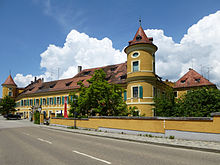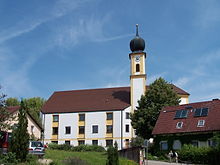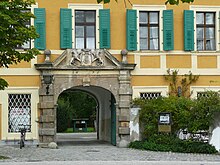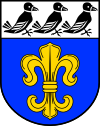Wiesent (municipality)
| coat of arms | Germany map | |
|---|---|---|
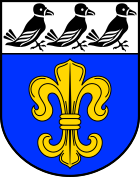
|
Coordinates: 49 ° 0 ' N , 12 ° 23' E |
|
| Basic data | ||
| State : | Bavaria | |
| Administrative region : | Upper Palatinate | |
| County : | regensburg | |
| Height : | 332 m above sea level NHN | |
| Area : | 26.74 km 2 | |
| Residents: | 2616 (Dec. 31, 2019) | |
| Population density : | 98 inhabitants per km 2 | |
| Postal code : | 93109 | |
| Area code : | 09482 | |
| License plate : | R. | |
| Community key : | 09 3 75 209 | |
| Community structure: | 25 districts | |
| Address of the municipal administration: |
Bahnhofstrasse 1 93109 Wiesent |
|
| Website : | ||
| Mayoress : | Elisabeth Kerscher ( CSU ) | |
| Location of the community Wiesent in the district of Regensburg | ||
Wiesent ( Bavarian : Wiesnd ) is a church village and a municipality in the Upper Palatinate district of Regensburg in Bavaria ( Eastern Bavaria ).
The village lies at the foot of the Hermannsberg and was already an aristocratic seat at the time of Charlemagne .
geography
Geographical location
The community of Wiesent is located about 20 kilometers east of Regensburg on the foothills of the Bavarian Forest . The place Wiesent is traversed by the Wiesent , also called Höllbach here, which flows five kilometers further east into the Danube . The village is about three kilometers from the Danube and one kilometer from the nearest town of Wörth an der Donau.
population
The most populous district of the municipality is Wiesent with 1998 inhabitants, followed by: Kruckenberg 213 inhabitants, Ettersdorf 197 inhabitants, Dietersweg 53 inhabitants and Rupertsbühl and Petersberg with 35 inhabitants each. (Information from the municipal administration, as of December 31, 2010)
Neighboring communities
Wiesent borders the town of Wörth an der Donau in the south and east , the municipality Rettenbach in the Cham district in the northeast , the municipality Bach an der Donau in the west and the municipality Brennberg in the north .
Community structure
The political municipality Wiesent has 25 officially named districts:
history
Place name
The place name is likely to be of Germanic or Celtic origin.
Over the centuries this name changed: Wisint / Wysunt (780) → Wysenndt → Wisent (1433) → Wissent (1666) → Wiesendt (1700) → Wiesent.
Prehistory and early history
Prehistoric sites around Wiesent have been secured. About 60,000 years ago, at the beginning of the last ice age , the first people are likely to have stayed in this area. Stone tools of the Neanderthals have been found from this time . Traces of the end of the Paleolithic are also secured. A stone ax from around 4000 BC was found in the Rupertsbühl district. Chr.
middle Ages
Wiesent was first mentioned in 780. At that time, a knight "Hito von Wisint" gave the Niederaltaich monastery 36 days of land near the hamlet of Wysunte. 1133 an episcopal servant Ulrich von Wysenndt is mentioned in a document. At that time the place belonged to the parish of Wörth and in 1433 there was already a church. Wiesent was the seat of its own rule with special jurisdiction, which had belonged to the Principality of Pfalz-Neuburg since 1505 . During the Reformation and the Thirty Years War , Wiesent became Lutheran under Count Palatine Otto in 1544. A school is mentioned for the first time in 1570. The district Dietersweg is mentioned in a fief book in 1422.
In 1620 Wiesent was raised to its own parish. The town was hit by the plague around 1625 and set on fire by the Swedes in 1633. In 1639 the foundation stone for the new building of the burned down church was laid and in 1695 the Wiesenter castle was built by Thimon von Lintelo.
hermitage
On November 6, 1696, Thimon von Lintelo received permission from the episcopal ordinariate to build a hermitage near Wiesent. The first hermit was Frater Johann Andreas Sierach. Numerous hermits followed him until 1787, with Fr. Onuphrius and Fr. Johann Nadler, the last to occupy the hermitage. Even today, the "hermit Bridge" and the adjacent property remember "hermit" area on the way to Dietersweg to the hermitage .
Modern times
In 1707 the dilapidated old church was demolished and a new parish church was built. On April 23, 1801, it was destroyed by fire and was only rebuilt after 18 years. Wiesent belonged to the Burglengenfeld Regional Court from 1505, later it came to the Regenstauf Regional Court. In Wiesent there was also a first class patrimonial court . This was temporarily administered by the first class patrimonial court ( lordship court ) in Schönberg of the princes of Thurn and Taxis . These last remnants of aristocratic rule were abolished in the 1848 revolution . In 1836 Wiesent came to the Stadtamhof district court for administrative purposes and to the Wörth district court in 1848. Since 1862, when the district offices were set up, it has belonged to the Regensburg District Office, corresponding to the current Regensburg district . In 1858 Wiesent tried to build a new school, the location of which was today's Bahnhofstrasse. The war memorial was inaugurated in 1895.
Ancient handicrafts
In the 19th century, handicrafts were at home in Wiesent. Organ builder Ludwig Ehrlich lived here from around 1802 to 1812 and organ maker Johann Rödl lived here in 1850. Noteworthy are the wrought-iron grave crosses from a former village cemetery that are still preserved around the parish church. They were made by the blacksmith's trade that was active in the village at that time.
graveyard
In 1892 a new cemetery was built and the cemetery that had been laid out around the church was given up.
Former Walhalla Railway
On May 1, 1903, the municipality got a connection to the Bavarian railway network by extending the Walhalla Railway from Donaustauf to Wörth . The total cost of the railway extension was 900,000 Reichsmarks, the Wiesent community contributed 10,000 RM. On December 31, 1968, the last freight train to Regensburg left the station.
20th century
After the Heilbergmühle was demolished in 1912, water power was used to generate electricity, which gave Wiesent a power supply. In 1905 the place had already been connected to the Bavarian telephone network. On August 3, 1913, a church building association was founded, which promoted the new construction and reconstruction of the parish church and ended with the consecration of the church on August 15, 1973.
Period from 1914 to 1945
Like all communities, Wiesent suffered from the burden of the two world wars. During the First World War , 53 men died from the community area. The site was spared from bombings and major incidents during World War II , and NSDAP local group leader teacher Muggenthaler burned all of Wiesent's files on the Third Reich at the end of the war in 1945, two days before the American invasion . During the war, numerous Wiesent citizens who were skeptical of the Nazi regime and resisted were suppressed. The pastor of Wiesent, Tiberius Burger, who was reported by the then Wörth mayor and local group leader of the NSDAP, Friedrich Horkheimer, suffered particularly in 1940, and had to endure a long negotiation battle with appeals and the fear of revocation of the teaching permit. The Mayor of Wiesent, Wolfgang Kehrer, was an exception. He used his power and his leeway to undermine unworthy orders.
Post-war and modern
It took some time for the place to recover after the war. In 1960 the construction of a new school began, in which lessons have been held since 1961/62 until today; the school was expanded and completely renovated from 1993 onwards. In the following years, a new kindergarten was inaugurated in 1975, a new fire station was moved into in 1981 and a new school sports building opened in 1984. The village square was redesigned in 1994 as part of the urban development program . At the end of the 20th century, the Wiesent community created numerous new development areas, such as Wiesent-Nord , Am Grubweg and Schmiedfeld .
21st century
Wiesent has continued to grow in recent years, and investments have been made in infrastructure projects. More new building areas were created and the community has continued to develop well, above all through innovative ideas such as an eco-package for building areas, an energy box for apartment buildings, kindergarten and administration as well as the voluntary school association and inter-municipal cooperation with the neighboring municipality of Wörth. The municipality is currently setting the course for investments in renewable, environmentally friendly energy, energy-saving technology, as well as in broadband supply and further development of the infrastructure. The municipality was one of the first in the district to develop a climate protection concept.
In 2008, Wiesent was chosen as the district winner for the competition "Our village has a future - our village should be more beautiful" and thus represented the district of Regensburg in the 2009 district decision.
Incorporation and outsourcing
On January 1, 1972, the previously independent communities Dietersweg and Kruckenberg were incorporated with all their districts. Dietersweg brought in the districts Dietersweg, Eckenzell, Eidenzell, Grafenöd, Heilsberg, Hermannsöd, Höhenberg, Kirnberg, Mitterroith, Neuhaus, Pangerlhof, Pinklhof (Oberroith), Ponhof, Rupertsbühl, Sandweg and Wiedenrös, Kruckenberg and Lehmhof come from the former municipality of Kruckenberg. With the regional reform it was incorporated into the Wörth administrative community . On January 1st, 1980 Wiesent regained independence. As of July 1, 2014, 4.6 km² were incorporated from the community-free area of Forstmühler Forst .
Until 1949 Wörthhof was a district of Wiesent, which was spun off to Oberachdorf on March 23, 1949 . From 1945 to 1948, the community of Kiefenholz came to Wiesent temporarily at the instigation of the US military government . On April 1, 1948, Kiefenholz was independent again.
In 1946, the community of Dietersweg belonged briefly to the community of Wiesent, prompted by the US military government, after which it became independent again. On January 1, 1972, it was incorporated with all districts to Wiesent.
From 1945 to 1948 the former community of Kruckenberg was briefly incorporated into Wiesent by the US military government, after which it was independent again. On January 1, 1972, it was incorporated with all districts to Wiesent.
Population development
Between 1988 and 2018 the municipality grew from 2,063 to 2,625 by 562 inhabitants or by 27.2%.
Religions
As in the entire Upper Palatinate, the majority of the population in Wiesent is Roman Catholic. The Catholics belong to the parish of Mariä Himmelfahrt Wiesent and thus to the Donaustauf deanery , which is assigned to the diocese of Regensburg .
politics
- CSU : 7
- FAW : 7
Municipal council
The local council consists of the first mayor and 14 councilors. In the local elections on March 15, 2020, 1,398 of the 2,159 residents eligible to vote in the municipality of Wiesent exercised their right to vote, bringing the turnout to 64.75%.
Mayor until 1946
- Schellerer (1876–1888)
- Sauerer (1888-1900)
- Gold (1900–1906)
- Rösch (1906-1919)
- Schweiger (1919–1933)
- Fichtl (1933–1934)
- Kehrer (1935-1946)
Mayor from 1946
- Deml (1946–1948)
- Kehrer (1948–1952)
- Deml (1952-1970)
- Kiener (1970–1983)
- Walchshäusl (1983–1990)
- Johann Rösch (1990-2010)
- Elisabeth Kerscher (since 2010)
Johann (Hans) Rösch was appointed former mayor on January 8, 2011. Elisabeth Kerscher (CSU) has been the first female mayor since October 24, 2010. She was re-elected in the local elections on March 15, 2020 with 93.19% of the vote.
Intermunicipal cooperation
As part of the intermunicipal cooperation , Wiesent participates in various collaborations with the neighboring city of Wörth. So Wiesent transferred the registry office to Wörth, in return Wiesent received the administration of the Wörth-Wiesent elementary school association. The Wörth adDonau sewage treatment association cooperates with the municipality of Wörth and the “Donau.Wald family support point” also exists with Wörth and Brennberg . This pilot project is funded by the Free State of Bavaria and is considered a new information and contact point for families. There are a total of five partnerships with the city of Wörth an der Donau.
Others
On June 10, 2016, the Bavarian Prime Minister Horst Seehofer visited the community of Wiesent on the occasion of the 70th anniversary of the CSU district association Regensburg-Land.
coat of arms
|
Blazon : "Under a silver shield head, inside three black ravens turned to the left, in blue a golden heraldic lily."
The coat of arms has been used since 1977. |
|
Flood polder Wörthhof
The Wiesent community, although not directly affected by the “ Wörthhof ” flood polder planned by the Bavarian State Ministry for the Environment and Consumer Protection , has unanimously and emphatically spoken out against the plans of the Bavarian state government, as numerous farmers from the municipal area are cultivating land in the polder area. The district administrator of the district of Regensburg Tanja Schweiger is also skeptical. A groundwater problem that has existed for years, caused by the Danube, and the threat to the drinking water supply of Wiesent, which is also in the vicinity of the planned flood polders, speak clearly against it. A strong protest movement called "IG-Polder" has emerged from numerous farmers and citizens.
On April 11, 2015, the CSU district chairwoman and Minister of Social Affairs Emilia Müller visited the district of Kiefenholz to familiarize herself with the problem of flood polders.
Due to the coalition agreement concluded between the Free Voters and the CSU after the state elections on October 14, 2018 in Bavaria , the flood polder concept is no longer being pursued in the Regensburg district. This was a key demand of the Free Voters. The funds released are to be invested in decentralized flood protection along the Danube and all its inlets.
→ History of the Danube near Wörth / Wiesent : See also Wörth and the Danube
Granite mining - quarry in the Princely Thiergarten of Thurn und Taxis
After a medium-sized construction company had already expressed interest in granite quarrying in the Fürstliches Thiergarten , a local recreation area in the Ettersdorf district, since 2016, the formal approval application for the construction and operation of a granite quarry with a mobile processing plant was submitted to the Regensburg district office on October 9, 2018 submitted the extracted rock. An interest group was founded against this project; the entire municipal council also speaks out against it.
Culture and sights
The Obermühle and Untermühle, the castle and the Lieblwirt are among the oldest buildings in the village .
Castles and Palaces
- Burgstall Neuhaus , a lost castle on the summit plateau of the Heilsberg; In 1213 the further construction of the castle was stopped.
- The castle ruins of Heilsberg (near the Pangerlhof), mentioned for the first time in the middle of the 12th century, built by the Truchessen of Heilsberg and Eggmühl , abandoned in the 16th century. Today only parts of the keep and the curtain wall are preserved. Since 2005, work on the preservation of the ruins has been carried out by the "Friends of the Heilsberg Castle Preservation Association".
- Wiesent Castle : The elongated building with two corner towers was built by the Lords of Wiesent, later owners were the Lords of Falkenberg, Count Thimon von Lintelo and the Princes of Thurn and Taxis . After partial destruction around 1630 , it was rebuilt by 1695 . Today the castle is privately owned and contains several apartments and shops.
- The Hudetz Tower (in Wiesent Castle): Hudetz Museum and Hudetz Memorial, as well as space for exhibitions and documents of earlier room and living conditions.
- Ettersdorf Hunting Lodge : Today in private ownership; the 18th century farm building (Ettersdorf 1) is an eaves-standing, steep-roofed building made of quarry stone and brick.
Churches and monasteries
- Heilsberg Monastery (building no longer exists)
- Catholic Parish Church of the Assumption: The baroque choir from 1707 is still preserved from the original church. The tower was rebuilt after a fire in 1818. The church was extended and restored with a modern nave in 1973.
- Catholic side church St. Bartholomäus Dietersweg : eaves-standing hall with retracted choir and facade tower with pointed roof, neo-Gothic, ins. 1896; with equipment. 1902 consecration of the church.
- Kath. Filialkirche St. Matthäus Kruckenberg: Hall building with hipped gable roof and facade tower with pointed roof, classicistic, 1845; with equipment.
- Catholic side church of the Visitation of the Virgin Mary in Wiesent (so-called Lindenkapelle): Hall building with a gable-mounted apse, gable roof turret with onion dome, plaster structure and shingle roof, neo-Gothic, 1831–32; with equipment.
Buildings
- Haus Hermannsberg: Education and leisure center of the Catholic youth welfare of the diocese of Regensburg .
- The Nepal-Himalaya pavilion of the Expo 2000 in Hanover was rebuilt on the Martini plate in Wiesent in 2003 and has since been open to the public during certain opening times. A viewing and viewing garden with more than 2500 different plant species was created around the pavilion .
Places
- Historic castle square (village square) with village fountain and war memorial.
Others
- Figure of St. Nepomuk on the base of the coat of arms (bridge near Schlossplatz): sandstone, late baroque, around 1760.
- Summer cellar: The outer summer cellar was part of Schloss Wiesent since 1812 . Later it was used by a brewery that was located in the castle and a local restaurant for beer storage. In 1994, as part of the redesign of the village square, the area was acquired and the basement was then made usable. Public events of a social and cultural nature have been held there since 2011.
- In 1925 numerous interesting and old wrought iron crosses were placed around the church.
All architectural monuments
In the vicinity
nature
Part of the Hell Nature Reserve is located in the municipality .
Along the state road to Regensburg, between Wiesent and Sulzbach , a large closed forest area extends in the hilly landscape of the Bavarian Vorwald, the Princely Thiergarten of Thurn und Taxis. The wildlife park is one of the most beautiful and mighty in Germany. It is completely fenced, 2800 hectares in size, with roe deer, deer, wild boar, lynx, beavers, otters, black storks and other animals. It was laid out in 1813 as a hunting forest for the Princes of Thurn and Taxis.
Sports and clubs
In Wiesent there are well-developed sports facilities and a rich club life, including:
- Sports club Wiesent (SV Wiesent), founded in 1933.
- Rifle club Edelweiß Wiesent (air rifle shooting), founded in 1882.
- Beekeeping Association, founded in 1894.
The Wiesent volunteer fire brigade (founded in 1874) and the volunteer fire brigades in the districts of Kruckenberg (founded 1889) and Dietersweg (founded 1896) provide fire protection and general help in the municipality and beyond.
Good armourers
There are numerous equestrian sports facilities at Gut Waffenschmiede. A dressage and riding hall, outdoor riding and lunging area as well as a paddock and a rider's lounge are integrated.
leisure
There are many cycling and hiking trails in the municipality. Wiesent is located on the Danube Panorama Trail. This hiking trail is 220 km long and leads from Neustadt an der Donau to Passau . The next indoor swimming pool is in Wörth an der Donau.
Regular events
- May 1st: Traditional maypole erection on Schlossplatz by KLJB Wiesent
- Annual Christmas market with numerous exhibitors and a large supporting program on the village square
- Annual Josefimarkt (spring and artists' market with living workshops and around 90 exhibitors)
In addition, numerous events of the local associations as well as cultural and social events take place in the summer cellar.
music
A church choir and the Bavarian band "Kerscher-Musikanten" have existed in the village for a long time. There is also a children's choir and the women's choir "Swimmy".
Culture Initiative - Donau.Wald.Kultur
The intercommunal cultural initiative “Donau.Wald.Kultur” exists with the neighboring communities of Wörth and Brennberg and the communities of Pfatter and Rettenbach . Since 2012, a diverse program with artists from various directions has been offered.
Economy and Infrastructure
In Wiesent there is good medical care, day care with an outpatient care service from the BRK , a postal agency, and there are also numerous trade, craft and service companies.
Wörth-Wiesent business park
On January 14, 2010, the inter-municipal cooperation with the neighboring municipality of Wörth an der Donau was decided.
This collaboration resulted in the establishment of the 160,000 square meter “Wörth-Wiesent industrial park” in the same year .
Bavarian quality award
For this joint project, Wörth and Wiesent received the Bavarian Quality Prize Special Prize 2013 "for particularly business-friendly and innovative cooperation projects between several municipalities with a model character". This business park is conveniently located right next to the federal motorway BAB 3 exit Wörth / Wiesent (AS 104a). Numerous craft and service companies as well as the manufacturing industry have already settled here.
Viticulture
The Baierwein , which was mentioned in a document in the 8th century, thrives in the vineyards in the district of Kruckenberg ; numerous wine bars can be found here. According to an old document, viticulture was introduced in the Wiesent community around the year 1100. The village is located in the second smallest wine-growing region in Germany and the smallest in Bavaria, on the wine route, which is the shortest wine route in Germany with a length of 20 kilometers.
traffic
About one kilometer south of Wiesent, the A 3 motorway with the Wörth / Wiesent motorway junction (AS 104a) passes. Due to its location on the R 42 district road, there is a direct connection to the Falkensteiner Vorwald as well as to Falkenstein and Cham . In a north-south direction, the state road St 2146 leads from the direction of Cham via Wörth and Wiesent on over the Danube bridge Wörth– Pfatter to the federal road B 8 and direction Sünching . In a west-east direction, the St 2125 runs from Regensburg via Wiesent and Wörth to Straubing.
media
The Donau-Post , a local edition of the Straubinger Tagblatt and the Wörther Anzeiger , a local edition of the Mittelbayerische Zeitung and the Regensburger Wochenblatt , an edition of the Wochenblatt publishing group, appear in the community . In addition to national programs, radio stations Radio Charivari , Radio Gong FM , Radio AWN and the regional television station TVA can also be received in the municipality .
Public facilities
- Community center
- kindergarten
- Big day care for children
- Zwergerltreff
- Youth room
- Community library
- Recycling center
education
- Elementary school Wörth-Wiesent with eleven full-time teachers and 234 students (as of 2015/2016).
Middle School Association :
As part of the intermunicipal cooperation, the Middle School Association of the Vorderer Bayerischer Wald - Donautal was founded in April 2010 . This school network is considered to be a showcase project across all districts and districts.
The members of the school association are:
- Middle School Association Wörth-Wiesent, consisting of the city of Wörth an der Donau, Wiesent municipality, Pfatter municipality, Bach an der Donau municipality
- Middle School Association Falkenstein, consisting of the market Falkenstein , municipality Rettenbach , municipality Brennberg
- Community Wiesenfelden
Wiesenter Heimatlied
Composed by Pastor Tiberius Burger
1st verse:
Where the Hermannsberg summit
protrudes into the clear blue sky,
Where a friendly little village greets
In the vast Danube valley ,
In my dear home my,
I always, always want to be.
Personalities
Bearer of the Federal Merit Medal
- 2014, August 6th: Peter Lutz, local home keeper, district home keeper with a focus on building and monument conservation.
Honorary citizen
- 1903, January 14th: Alois Flierl, teacher
- 1928, December 5th: Anton Doeberl, pastor
- 1950, June 2nd: Tiberius Burger, pastor
- 1952, July 4th: Johann Rösch, Mayor from 1919 to 1933
- 1952, July 4th: Wolfgang Kehrer, Mayor from 1935 to 1946
- 1970; April 10: Karl Anton Hudetz (born March 29, 1890 - † February 16, 1977), painter and graphic artist
- Johann Walchshäusl (born April 25, 1917; † October 2005), mayor from 1983 to 1990
- 2015, May 2: Johann (Hans) Rösch, Mayor from 1990 to 2010, Former Mayor
Sons and daughters of the church
- Thadäus OCap. (Born January 26, 1858 in Wiesent; † June 10, 1926 in Bogota ) Benedictine , Father and Pastor of Río Bueno , also known as "Water Doctor"
Others
Joan Antidea Thouret (1765-1826), canonized in 1934, moved in 1796 to the Solitariern the castle Ettersdorf and stayed there a long time.
literature
- Tourist association Bayerischer Vorwald: Bayerischer Vorwald - area Wörth ad Donau Buchdruckerei Eduard Schramm, Wörth / D. 1969.
- Harald Stark : The Notthracht family - looking for traces in Egerland, Bavaria and Swabia , Späthling, Weißenstadt 2006, ISBN 3-926621-46-X (to Heilsberg Castle).
- Wilhelm Gegenfurtner: Chronicle of the community Wiesent . Ed .: Community of Wiesent. Wiesent 1980, DNB 820379972 .
- Thomas Hausladen: History of the Catholic parish Wiesent. Wiesent (private print) 1894; Unchanged reprint Regensburg (Society for Family Research) 1993.
- Karl Hermes: The recent development of Wiesent from a geographical point of view - special print from the 244-page chronicle of the Wiesent community, 1989.
- Wiesent community: 1225 years Wiesent - Festschrift Wiesent community 780 - 2005
- Traudl Neumeier; Community Wiesent (ed.): Community Wiesent - tell old pictures. Geiger, Horb am Neckar 1998, ISBN 3-89570-451-2 .
- Heinrich Lippert: School history Wiesent 1575 to 2005. Wiesent 2004.
- Bavarian State Office for Monument Preservation (ed.): The art monuments of Upper Palatinate & Regensburg - XXI District Office Regensburg. In: DerS (Ed.): Die Kunstdenkmäler von Bayern. Munich 1910 DNB 366496697 .
- Albert Eichmeier, Peter Lutz: Resistance and persecution in Wiesent during the Nazi era. Wiesent 2015, ISBN 978-3-88246-346-1 .
Individual evidence
- ↑ "Data 2" sheet, Statistical Report A1200C 202041 Population of the municipalities, districts and administrative districts 1st quarter 2020 (population based on the 2011 census) ( help ).
- ^ Community Wiesent in the local database of the Bavarian State Library Online . Bavarian State Library, accessed on November 28, 2017.
- ^ "The beginnings of the Reformation in the Wiesent community" in: Regensburger Contributions to Local Research , accessed on November 10, 2016.
- ↑ Diethard Schmid: Altbayern row I issue 66: Regensburg II. The district court Haidau-Pfatter and the Palatinate-Neuburg rule Heilsberg-Wiesent. Munich, 2014, from the series: Commission for Bavarian State History (Ed.): Historischer Atlas von Bayern , ISBN 978-3-7696-6558-1 , p. 599.
- ↑ Wiesent in the Third Reich: Remembrance of the Resistance , accessed on December 1, 2014.
- ^ "Resistance and persecution in Wiesent during the Nazi era" in: Regensburger Contributions to Local Research , accessed on November 10, 2016.
- ↑ District winners Our village should become more beautiful: 2008 award winners ( memento from September 24, 2015 in the Internet Archive ), accessed on November 14, 2014.
- ^ Wilhelm Volkert (ed.): Handbook of Bavarian offices, communities and courts 1799–1980 . CH Beck, Munich 1983, ISBN 3-406-09669-7 , p. 555 .
- ↑ Official Journal Upper Palatinate 6/2014
- ↑ https://wahlen.landkreis-regensburg.de/kommunal2020/20200315/09375209/html5/Gemeinderatswahl_Bayern_66_Gemeinde_Gemeinde_Wiesent.html
- ↑ https://wahlen.landkreis-regensburg.de/kommunal2020/20200315/09375209/html5/Gemeinderatswahl_Bayern_66_Gemeinde_Gemeinde_Wiesent.html
- ^ Hans Rösch: Appointment as former mayor , accessed on November 29, 2014.
- ↑ https://wahlen.landkreis-regensburg.de/kommunal2020/20200315/09375209/html5/Buergermeisterwahl_Bayern_67_Gemeinde_Gemeinde_Wiesent.html
- ^ Walter Schiessl: The district CSU was in a party mood . On the occasion of his 70th birthday, Prime Minister Horst Seehofer gave the speech at the Nepal Temple in Wiesenter and received a lot of applause. Ed .: Mittelbayerische Zeitung. June 13, 2016 ( online ).
- ↑ Entry on the coat of arms of Wiesent (municipality) in the database of the House of Bavarian History , accessed on August 5, 2020 .
- ^ City of Wörth ad Donau: New arguments against the flood polders , accessed on November 28, 2014.
- ↑ Interest group: Gegen Flutpolder , accessed on February 10, 2015.
- ↑ Interest group: Visit of the Bavarian Minister of Social Affairs Emilia Müller , accessed on June 8, 2015.
- ↑ Polder construction in the district of Regensburg: Flood polders stopped , accessed on December 30, 2018.
- ↑ The Fürstlicher Thiergarten recreation area. Altenthann parish, accessed on January 4, 2019 .
- ↑ Citizens' initiative: Protest by Ettersdorf residents will be more popular on May 4, 2016 on Mittelbayerische.de
- ↑ Granite mining: Ettersdorf Fürstlicher Thiergarten
- ↑ Culture initiative - "Donau.Wald.Kultur".
- ↑ Bavarian Quality Prize : Special Prize 2013 , accessed on December 2, 2015.
- ↑ "Viticulture near Wörth ad Donau" - Kruckenberg - Wiesent in: Regensburg Contributions to Local Research , accessed on November 9, 2016.
- ↑ Wiesenter Bürgerhaus: Inauguration on March 27, 2014 , accessed on December 1, 2014.
- ↑ Grundschule Wörth - Wiesent in the school database of the Bavarian State Ministry for Education and Culture , accessed on August 5, 2017.
- ↑ Middle School Association of the Vorderer Bayerischer Wald ( Memento from December 19, 2014 in the Internet Archive ), accessed on December 14, 2014.
- ^ Johann Walchshäusl: Honorary Citizen and Mayor , accessed on November 16, 2016.
- ↑ Christine Riedl-Valder: Wiesent, Hermannsberg - Life in Silence and Solitude. House of Bavarian History, accessed on October 3, 2016 .
Web links
- Official homepage of the community of Wiesent
- Wiesent municipality at the Bavarian Administration Service
- Heilsberg Castle at www.notthracht.de
- Entry on the coat of arms of Wiesent (municipality) in the database of the House of Bavarian History
- The noble family von Lintelo zu Wiesent
- Wiesent (municipality): Official statistics of the LfStat
- Churches in Wiesent
- Aerial photos of Wiesent and Wörth



